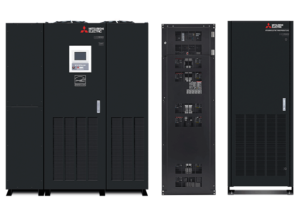Uninterruptible Power Supply (UPS Systems)
An uninterruptible power supply (UPS) is a device that provides backup power to electrical systems in the event of a power outage or fluctuations in the main power supply. UPS help to ensure that connected devices or systems can continue to operate smoothly even during a complete loss of utility power.

Here’s how a typical UPS works:
- Power Input: Utility or Generator power feeds the UPS and is conditioned by the UPS to supply power to the critical connected load while simultaneously keeping a charge on the UPS internal battery while the main power is available. Most UPS condition the incoming power to stabilize voltage levels and filter out any electrical noise or surges.
- Monitoring: The UPS constantly monitors the quality of the incoming power supply. It keeps track of voltage levels, frequency, and other parameters to ensure they remain within acceptable limits.
- Power Conditioning: If the UPS detects any anomalies in the incoming power, such as low voltage, high voltage, or frequency variations, it takes corrective action. The UPS may employ voltage regulation or filtering techniques to stabilize the power and provide clean energy to connected devices.
- Battery Backup: When a power outage occurs or the incoming power becomes unstable beyond the UPS’s inherent correction capabilities, the UPS utilizes its integral battery to ensure that clean, uninterrupted power continues to flow to the critical load. The internal battery becomes the primary power source, supplying electricity to the connected devices (for the specified length of battery run time or until available standby generators are running up to speed in which case the generator takes over the function of the utility power).
- Inverter: The UPS uses an inverter to convert the DC (direct current) power from the battery into AC (alternating current) power, which is compatible with the devices connected to it. The inverter ensures a smooth and uninterrupted power supply during the transition from the main power source to the battery.
- Battery Run Time: UPS batteries are sized to provide the desired runtime (in minutes) for the specified amount of UPS connected load (kW). Typical run times for facilities that also employed standby generators are 5 – 7 minutes, however longer run times are available. UL924 lighting, and other life safety systems, typically require 90 minutes or longer back up times and must comply with local and national electric codes. Consult your AHJ or a licensed professional engineer to understand the code requirements for your facilities.
- Power restoration: When utility or generator power returns, the UPS reverts back to normal operation and, if sufficient power is available, simultaneously powers the connected load while also recharging the UPS battery.
Uninterruptible Power Supply Systems (UPS) provide clean continuous power for your critical equipment or an entire facility. Universal Power provides UPS Systems and Data Center Power Distribution Solutions for every application. The Team at Universal Power will assist you with selection, specification and procurement of UPS for your specific needs. Many systems are in stock or available for timely delivery to meet your project schedule. We provide UPS for the following applications:
Universal Power will assist you with the selection and procurement of UPS for the following applications:
- UPS for Enterprise Data Centers and Colocation Facilities
- Rack Mount UPS
- UPS for Critical Environments
- UPS for Emergency Lighting
- UPS for Elevator Backup
- Single Phase UPS
Contact our Team for application assistance or for a UPS system proposal
Whatever critical power requirement you may have, Universal Power can help you to determine the specific requirements for your UPS System. Contact us for assistance, pricing, and lead times for all your critical power distribution needs.
